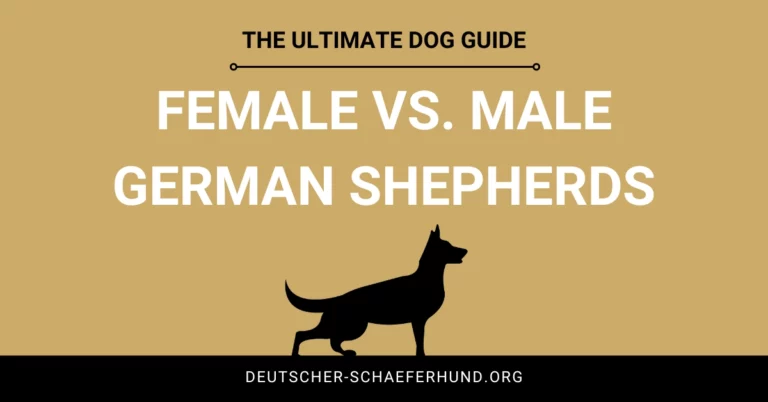So you’re certain you want a German Shepherd, but now you’re making the last key decision. Which sex do you choose?
When you’re talking about a female vs male German shepherd, there are advantages and disadvantages for both.
In this article, we will take a detailed look at various differences between male and female German Shepherds. We will compare their size, aggression, activity levels, feeding, temperament, and behavior. You will also learn who is more aggressive and protective. Keep reading to find out exactly what these differences are, and how they can affect your decision.
 Written By Sergey Uhanov – Certified Veterinarian.
Written By Sergey Uhanov – Certified Veterinarian.
Sergey Uhanov is a certified veterinarian for dogs over 10 years, breeding 3 dogs. He loves dogs and has his own pet clinic in Israel. He likes to help other people with their dogs by sharing his experience and knowledge.
History and Overview
German shepherd dogs are one of the most popular dog breeds in both the United States and the United Kingdom. They have traditionally been used for herding, guarding, police, military, and guide-dog roles.
Throughout history, this breed has developed several talents and has held several occupations, from chasing down criminals to performing in movies. The GSD is an intelligent dog, is easy to train, and is always up for a challenge.
Originally bred to herd groups of sheep, the high-energy GSD needs to constantly be entertained, or else he is likely to exhibit his boredom through excessive barking, digging, and chewing. The breed also tends to appear unfriendly and suspicious to strangers but that is not the case with family members.
The overall temperament of the dog depends on a variety of factors, including genes, gender, and socialization.
While the German Shepherd has many traits you might want in a dog breed, the breed might not be the right choice for everyone.
Female vs. Male Temperament
Generally, female GSD makes for sweeter and friendlier companions. Male GSDs tend to be territorial and urinate wherever they go to mark their territory. They are also much prouder.
Female German Shepherd dogs tend to be gentler and friendlier towards their owners and people in general. However, keep in mind that your dog’s temperament depends on his/her socialization skills.
Whether you opt for a male or female GSD, expose them to new persons and surroundings from a young age so that they grow up to become well-mannered and well-socialized dogs. New GSD owners may consider enrolling their puppy in obedience kindergarten classes.
Taking your dog out for regular strolls in the park and introducing the breed to new people and other pets will also improve their socialization skills.
With their primary family, GSD’s are playful and lively but may exhibit signs of possessiveness. While this makes the dog breed an excellent watchdog, visitors or other dog owners might not appreciate it.
What About Feeding?
As male German Shepherds are reasonably larger than their female counterparts, they need to be fed a larger amount of food. It is generally recommended that feed your dog 3-4 cups of healthy dog food, divided into two servings.
The amount of food and nutrition your dog needs depends on its age, size, build, and metabolism. When it comes to nutrition, dogs are like people and have different dietary needs. Not all dogs require the same amount of food. A highly active and energetic dog will undoubtedly require more food than an elderly dog.
The quality of food also plays an important role in improving their overall health.
The superior the quality of the dog food, the more nourishing it will be for your pet. If your GSD is gaining weight or losing weight too quickly, take them to the vet.
GSDs grow at a rapid pace between 4 and 7 months of age so some special care must be taken if you are raising a puppy. During this time of growth, they can be highly susceptible to bone disorders.
Additionally, over-feeding your new puppy and permitting them to gain weight too quickly can result in joint problems.
Size Comparison
Females tend to be smaller than males and less muscular. This is of course relative. There will always be small males and large females, and German shepherds are generally large dogs anyway.
Male German Shepherds are generally larger than their female counterparts and have a height ranging from 24 to 26 inches, while females stand about 22 to 24 inches tall. Their weight ranges from 75 to 95 pounds.
Depending on the living situation and the role you are planning to utilize your new GSD for, size can matter a great deal.
Activity Levels
Both male and female German Shepherds are highly energetic and require several hours of spirited exercise.
Simply put, a GSD is not the breed for you if you enjoy being lazy and watching TV all day and expect your dog to entertain themselves.
GSDs are packed with energy and will indulge in destructive behavior if they are unexercised.
If you are in need of an energetic companion that will accompany you for your morning runs then undoubtedly, this breed is the perfect choice for you.
Gender Personality Traits
Male German shepherds, like most male dogs, are more dominant than females, with females normally being gentler and much friendlier towards both their families and outsiders. This isn’t fixed in stone, however. A huge majority of a dog’s temperament revolves around how they are raised.
And any puppy, male or female, that is regularly exposed to other people and animals and socialized regularly will be more relaxed and calm in a variety of situations.
Commonly male GSDs tend to be more aloof and proud than females, but still just as curious and enthusiastic about play and learning. Whether these differences are present and how apparent they may be will vary depending on the traits of the parent dogs.
This is why it is important to be able to meet and get to know each parent dog as you are selecting between male and female German shepherd puppies.
Are Male or Female GSDs More Protective?
There is no doubt that the male has a fierce exterior. However, for the most part, German Shepherds are calm, gentle, and loving animals.
Unfortunately, though, males can have moments where they live up to the German Shepherd characteristics when they are overprotective. Males can be more territorial and mark more often than females, especially if they are unneutered.
In the same way, a male can compete for dominance more than females if he sees you lacking in strong leadership. Again though, this will only ever be a problem if you don’t train your dog correctly. Males can be more protective of their surrounding area, while females are more protective of their families.
Since female German shepherds have the “pack” instinct, they will be more protective of your family than their male counterparts.
A few other distinct traits to mention:
One person connection
Males tend to bond with one person in particular and be more territorial over that person.
Of course, a male will love the rest of the family, but don’t be surprised if everyone comes to understand the special bond that your male German shepherd has with “their” person.
Males are usually better from a personal protection standpoint, because of their larger size and tendency to bond with one person.
Possessiveness Over Items
Females are less possessive over items and personal effects than males, and less likely to bond strongly with one person.
Instead, females tend to love ‘the pack’ and treat your family equally, unless there’s obviously someone who feeds, manages, and trains them.
Training and sensitivity
Females are easier to train and more sensitive than males.
Their smaller size, greater agility, and temperament mean they’re a better choice for obedience training and events. Females also mature faster than males, which can make them easier to train.
Strangers and children tolerance
Females are more tolerant of strangers and children, in general as well.
Female dogs also go into heat, usually twice a year, unless they are spayed, which can cause some personality changes.
Are Male or Female GSDs Less Aggressive?
Male German shepherd dogs are significantly more likely to show aggression than females.
Training a German Shepherd not to be aggressive can be challenging if that’s your goal.
However, training your Shepherd not to be aggressive will alleviate some opportunities for conflict with other people and animals.
Things to consider: families with children may prefer a female as a playmate, whereas male dogs may be more appropriate for owners with security concerns.
To prevent over-guarding and aggressive behavior, German shepherd dogs should have socialization and obedience training at a young age which will reduce the chances of him causing harm to someone else or getting into fights with other pets.
Training your male GSD not to be aggressive has some upsides, you can stop fitting him in a muzzle whenever you leave the house, fewer complaints about him barking hostilely, but can be a downside if guarding your home is a priority.
The first thing recommended to do is identify what is causing the aggression in the first place. You can then go about dealing with the underlying problem. To reduce aggression, training will need to consist of socialization with other pets and people.
You will also need to use obedience commands to increase your control. Some deterrence measures may also be required to prevent his aggression from developing further.
Are Female GSD Used as Police Dogs?
Most, but certainly not all K9 police dogs, are male. As far as why males are larger and stronger thus more intimidating.
The temperament traits needed for patrol work are more frequently found in males, males don’t go through heat cycles which can interfere with training and work, and there is commonly a certain degree of “manly” factor involved.
In regards to police and military work, this tough exterior equates to a good number of police departments, K9 trainers and handlers being more drawn to males just because they are perceived as being more macho.
The female German shepherd is considered a better pick for family protection as opposed to one-to-one protection, including but not limited to personal security, military, police, or K-9 work.
The German shepherd breed displays the versatility, strength, and courage that makes it exceptionally suitable for police work.
Their heavy coats allow them to work under colder conditions, loyalty to their handlers is absolute and bravery is well documented. In addition, their presence seems to have an inhibitive psychological effect on potential offenders.
German shepherds trained to apprehend will invariably make a successful arrest despite the fact they are trained only to hold, never to be savage. Male dogs are favored for police duties but some females are chosen.
In addition to being in perfect physical condition, they must have particular personality traits that make them suitable for police work: even temperament, pursuing instinct and sound character are essential.
Because of their intelligence and curiosity to learn, male German Shepherds are easier to train for K9 duties compared to the female GSD may be easier to train and more sensitive to commands and cues, which may be a better pick for a service dog or therapy dog work.
How often are female GSD “in heat” during the year?
Intact female dogs (dogs that have not been surgically spayed), and that are sexually mature, which can vary in the timeframe, are said to be in estrus, “in heat”, or “in season”, during their occasional “cycle” in preparation to breed and reproduce.
Female German Shepherd dogs generally have their first heat cycle at around 6 to 12 months of age. Sometimes, a female GSD in heat may not have their first seasonal estrus cycle until they are 12 months of age or older, depending on that particular dog.
Remember, however, that this information is very general and not all female dogs will follow these exact patterns. Overall, each individual female dog’s heat cycle pattern tends to be relatively close to the basic average, lengthwise, however, lengths of heat cycles may differ from female to female when the female German Shepherd goes into heat.
In most cases, the average female German Shepherd Dogs heat cycle lasts about 3 to 4 weeks. Some female German Shepherds can come into estrus as early as every 4 months, while others may do so only once a year. Some canine heat cycles are shorter than average while other dogs may have longer ones (longer than 4 weeks).
Remember these three important facts concerning your female German shepherd dogs yearly heat cycles and prepare accordingly. First, assume your dog to be “in heat” for at least 21 days, possibly longer, which will vary due to your own individual female cycle.
Second, it is very important to keep in mind that conception is most likely to happen during the middle section of your GSD’s heat cycle – typically around 7 to 14 days after the heat cycles start.
Third, you will need to confine your female for the entire heat cycle – at least 21 days or more depending on your particular situation, to make sure that accidental mating does not happen.
Whether you keep her indoors or out you will need to make sure that her environment is “Boy proof”.
Believe me, you will need to think of all precautions because an interested male can be very vigilant in getting into a female’s area if she is in heat.
On average, the complete canine reproductive cycle takes about 6 months, which results in about 2 heat cycles each year for most female German shepherd dogs.
Be aware of all aspects of your pet’s health and behavioral life, prepare accordingly and you should both have a long and healthy life together.
If you do not use your dog for breeding it should be neutered, for its sake and yours.
Neutered dogs are easier to handle, and have fewer problems connected to their gender. Male dogs are very difficult to handle when on the trail of a dog in heat.
And, a dog in heat comes with its own problems of messiness, moodiness, and other dogs hanging around. Neutering is the best solution if your GSD will be a family pet only.
The Final Word
While there is no guarantee on the body size, temperament, or lifespan of any individual dog, females tend to live longer. In that case, a female German shepherd dog may be a better option for owners for whom a longer-lived pet is important.
Always remember that individual temperament and the way a dog is raised speak far more than genetic and sexual traits. As intelligent, devoted dogs, female or male German Shepherd, raised well, will be a fantastic addition to any family.
The one exception to this rule is if you’ve never had a dog before and have no idea how to train one properly and there are no resources in your town or city to help you train your dog.
If this is the case, it’s recommended that you choose a female dog, because of the dominance issues that can arise with a male dog who can recognize a lack of power structure and effective leadership in the household.
Whether you get a female vs male German shepherd, as long as you raise them correctly, you’re going to have a loving friend that will look after you for the rest of their lives.



